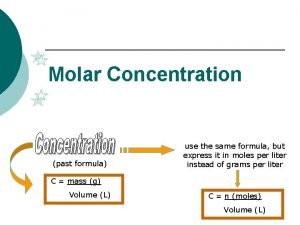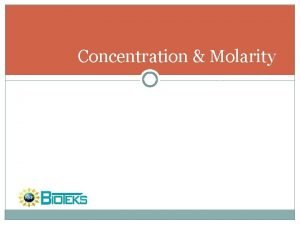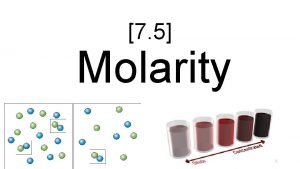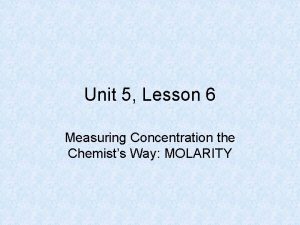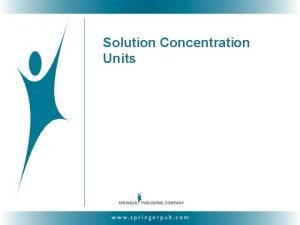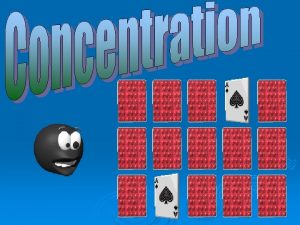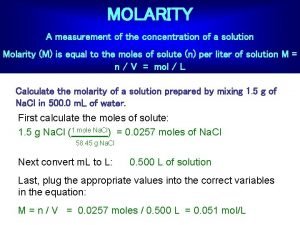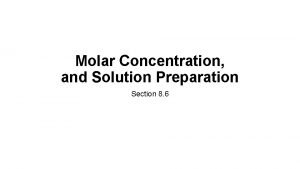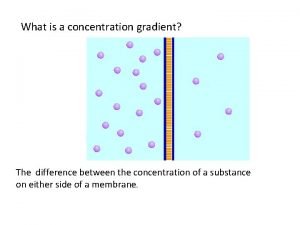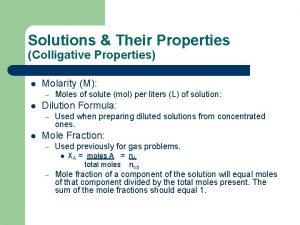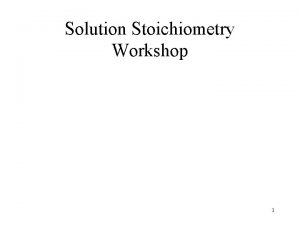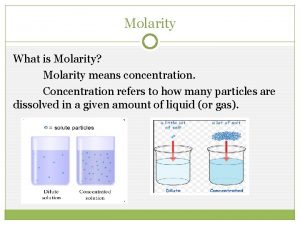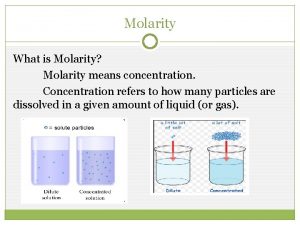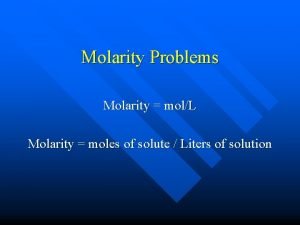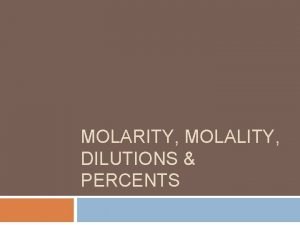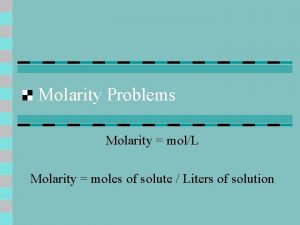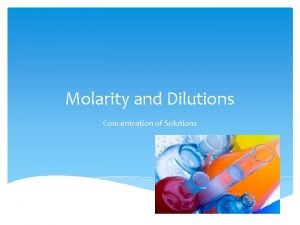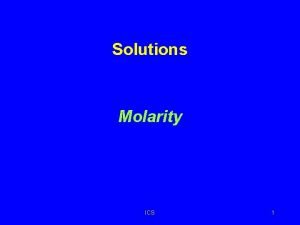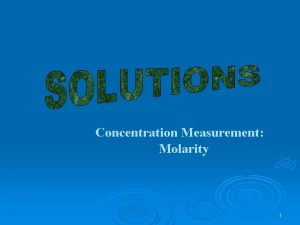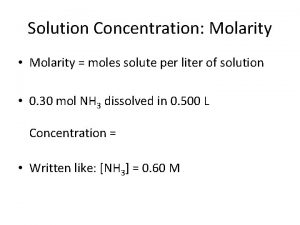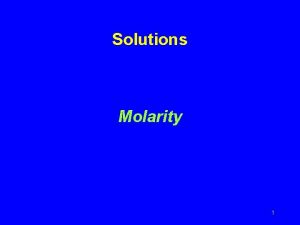Section 2 Concentration and Molarity Concentration In a














- Slides: 14


Section 2 - Concentration and Molarity Concentration In a solution, the solute is distributed evenly throughout the solvent. This means that any part of a solution has the same ratio of solute to solvent as any other part of the solution. This ratio is the concentration of the solution. Calculating Concentration Parts Per Million Concentrations can be expressed in many forms. One unit of concentration used in pollution measurements that involve very low concentrations is parts per million, or ppm. Parts per million is the number of grams of solute in 1 million grams of solution. For example, the concentration of lead in drinking water may be given in parts per million.

Formula for Parts Per Million from reference table. Used for concentration that are very small.

Molarity It is often convenient for chemists to discuss concentrations in terms of the number of solute particles in solution rather than the mass of particles in solution. Since the mole is the unit chemists use to measure the number of particles, they often specify concentrations using molarity. Molarity describes how many moles of solute are in each liter of solution. The symbol M is read as “molar” or as “moles per liter. ” Any amount of this solution has the same ratio of solute to solution.

Calculating with Molarity In working with solutions in chemistry, you will find that numerical Calculations often involve molarity. The key to all such calculations is the definition of molarity, which is stated as an equation below from the reference table.

Dilution: The process of adding more solvent to a solution. Dilution Formula: M 1 = Initial Molarity of solution V 1 = Initial Volume of solution M 2 = Final Molarity of solution V 2 = Final Volume of solution M 1 V 1 = M 2 V 2

Questions: When 0. 50 liter of a 12 M solution is diluted to 1. 0 liters, the molarity of the new solution is 1. 6. 0 M 2. 2. 4 M 3. 12 M 4. 24 M The molarity (M) of a solution is equal to the 1. number of grams of solute/liter of solvent 2. number of grams of solute/liter of solution 3. number of moles of solute/liter of solvent 4. number of moles of solute/liter of solution What is the total number of grams of Na. OH (formula mass = 40. ) needed to make 1. 0 liter of a 0. 20 M solution? 1. 20. g 2. 2. 0 g 3. 80. g 4. 8. 0 g

What is the molarity of a solution that contains 30. grams of Na. OH in 500. milliliters of solution? 1. 0. 75 M 2. 1. 3 M 3. 1. 5 M 4. 2. 6 M When 20. milliliters of 1. 0 M HCL is diluted to a total volume of 60. milliliters, the concentration of the resulting solution is 1. 1. 0 M 2. 0. 50 M 3. 0. 33 M 4. 0. 25 M How many liters of a 0. 5 M sodium hydroxide solution would contain 2 moles of solute? 1. 1 L 2. 2 L 3. 3 L 4. 4 L

What is the concentration of 10. moles of copper (II) nitrate in 5. 0 liters of solution? 1. 0. 50 M 2. 2. 0 M 3. 5. 0 M 4. 10. M Which solution is the most concentrated? 1. 1 mole of solute dissolved in 1 liter of solution 2. 2 moles of solute dissolved in 3 liters of solution 3. 6 moles of solute dissolved in 4 liters of solution 4. 4 moles of solute dissolved in 8 liters of solution What is the total number of moles of H 2 SO 4 needed to prepare 5. 0 liters of a 2. 0 M solution of H 2 SO 4? 1. 2. 5. 0 3. 10. 4. 20.

How many moles of solute are contained in 200 milliliters of a 1 M solution? 1. 1 2. 0. 2 3. 0. 8 4. 200 What is the molarity of a solution that contains 0. 50 mole of Na. OH in 0. 50 liter of solution? 1. 1. 0 M 2. 2. 0 M 3. 0. 25 M 4. 0. 50 M What is the molarity of a solution of Na. OH if 2 liters of the solution contains 4 moles of Na. OH? 1. 0. 5 M 2. 2 M 3. 8 M 4. 80 M

A town located downstream from a chemical plant was concerned about fluoride ions from the plant leaking into its drinking water. According to the Environmental Protection Agency, the fluoride ion concentration in drinking water cannot exceed 4 ppm. The town hired a chemist to analyze its water. The chemist determined that a 175 -gram sample of the town's water contains 0. 000 250 gram of fluoride ions. How many parts per million of fluoride ions are present in the analyzed sample? 1. 43 ppm What is the concentration of a solution, in parts per million, if 0. 02 gram of Na 3 PO 4 is dissolved in 1000 grams of water? 1. 20 ppm 2. 2 ppm 3. 0. 2 ppm 4. 0. 02 ppm

If 0. 025 gram of Pb(NO 3)2 is dissolved in 100. grams of H 2 O, what is the concentration of the resulting solution, in parts per million? 1. 0. 000025 ppm 2. 2. 5 ppm 3. 250 ppm 4. 4000 ppm An aqueous solution has 0. 0070 gram of oxygen dissolved in 1000. grams of water. Calculate the dissolved oxygen concentration of this solution in parts per million. 7. 0 ppm An aqueous solution contains 300. parts per million of KOH. Determine the number of grams of KOH present in 1000. grams of this solution. 0. 300 grams


 How to find grams to moles
How to find grams to moles Is concentration and molarity the same
Is concentration and molarity the same How to find the molarity
How to find the molarity Are concentration and molarity the same
Are concentration and molarity the same Measures of concentration molarity quiz
Measures of concentration molarity quiz Unit of concentration
Unit of concentration Molarity measurement
Molarity measurement What is molarity a measurement of?
What is molarity a measurement of? Molarnost
Molarnost Whats concentration gradient
Whats concentration gradient Movement of high concentration to low concentration
Movement of high concentration to low concentration Is molarity a colligative property
Is molarity a colligative property Molarity and stoichiometry
Molarity and stoichiometry Solubility and molarity relationship
Solubility and molarity relationship Molar solution
Molar solution
